Resurgence
Last year, Harvard embarked on its most ambitious construction project in decades, the Allston campus of the Harvard John A. Paulson School of Engineering and Applied Sciences. On a 36-acre piece of land, this project will house offices, classrooms, research facilities, and spaces to foster and facilitate creativity in engineering and the applied sciences.
In Harvard’s video announcing and detailing the institution’s plans for this expansion, the dean of SEAS, Frank Doyle, says, “Harvard University and Cambridge, Massachusetts: the two have shared a rich and symbiotic history for over 400 years.”
Doyle’s introduction is followed by a complication. Harvard has already expanded across the Charles River, into the nearest neighborhood in Boston: Allston, located just across the Charles River. Harvard Business School, Harvard Innovation Labs complex, and the university’s athletics complex all currently reside in Allston as relatively recent additions to Harvard’s property; Harvard constructed the athletics complex in 1903, then HBS in 1927. These were the forebears to the current foray into this neighborhood, and others in Boston – like Longwood, where the Harvard Medical School and the Harvard T.H. Chan School of Public Health reside.
In 2003, then-President Lawrence Summers announced a plan for more substantial expansion into Allston. The Harvard Crimson reported: “Summers’ plan calls for an interdisciplinary science campus integrating scientists working under the banners of FAS, Harvard Medical School (HMS) and the School of Public Health — the last of which would move to Allston in its entirety along with the Graduate School of Education.”
The dean of the Division of Engineering and Applied Sciences (now SEAS), Venkatesh “Venky” Narayanamurti, said at the time that if his department continued to grow, it would need more space than Cambridge could provide. Now, Harvard and Allston are giving engineering that space.
Engineers should be rejoicing, right? After centuries of being solely focused on liberal arts, Harvard has dedicated the time, resources, and capital to engineering. However, the centuries of dedication to the liberal arts, and the emerging dedication to engineering, do not come without negative side effects. Land, especially in cities like Boston and Cambridge, is part of a zero-sum game. As Harvard expands, communities shrink, and too often these communities are low-income or communities of color.
Physical Impact
Based on data from Harvard’s building records, Harvard owns 9.56 percent of the land in Cambridge, 5.70 percent in Allston, and 0.27 percent in Boston. Nearly 27 million square feet, or over 600 acres, of land is owned by Harvard, much increased from its inception.

Over time, as Harvard expanded its educational scope with a medical school, a divinity school, a law school and more, it began demanding more space in these cities. However, when Harvard expands, something else must contract.
Gentrification
Harvard is not unlike other capital-rich entities. There is a long-running joke that Harvard is just a billion-dollar hedge fund with a school attached.
The Harvard Corporation, established in 1650, is the oldest corporation in the western hemisphere and one of the two governing bodies of Harvard University. The net assets of the Harvard Corporation are $44.6 billion, and they oversee an endowment of $37.6 billion. Harvard’s wealth immediately puts it in a position of power in the Cambridge and Allston communities. Small businesses and families simply cannot compete with Harvard’s buying power, and that has radically changed surrounding communities.
Gentrification is a general term for the influx of wealthier people into an existing space, such that, by mechanisms of economic and cultural displacement, the essential character of that space is changed. In this analysis, gentrification is shown to be a consequence of, or a necessity for, the expansion of wealthy entities like Harvard.
Gentrification started as a government strategy for urban restructuring. Former or contemporary industrial and working class communities would be uprooted and “restructured” to serve the interests of upper- and middle-class people. Now, the dominance of Harvard’s capital prioritizes the interests of the university over those of the people the university may displace. The result is the current state: Harvard’s sprawl on Allston and Cambridge.
A Different Cambridge
The “essential character” of a space is defined by the people and culture within it. To understand Harvard’s effect on the people, culture, and essential character of Cambridge, one must examine the changes in these attributes over time.
Harvard’s growth can be measured by many features, from the growth of the student population to the differences in actual measurements of Harvard’s physical size. The endowment is an example of one of these features.
Harvard’s endowment has grown, almost exponentially, from $1.6 billion in 1981 to its current value of $35.7 billion. Truncating the analysis to post-1990 and analyzing the differences in cost of living in Cambridge allows the most impactful and responsible insights to be garnered from the data. About 5 percent of the endowment each year is used to cover a third of Harvard’s operating expenses and expansion desires, and the value of this 5 percent figure grows each year with the growth of the endowment, which is facilitated by expert portfolio managers and the general growth of the market. In fact, the endowment has overperformed the market average return of 8.20 percent, allowing for more discretionary funds for everything from new concentrations to property purchases and undergraduate house renewal.
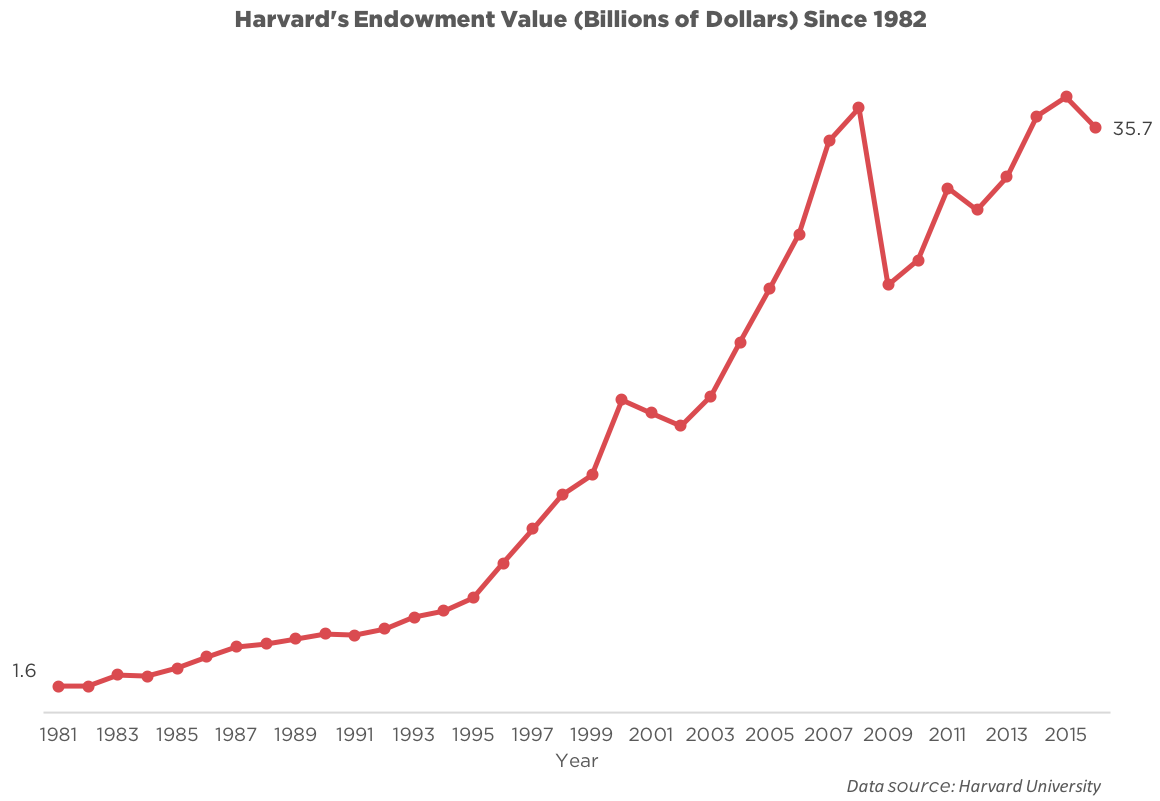
A more direct, and perhaps more accurate, proxy of Harvard’s growth is its literal growth in land usage in Cambridge. Since the year 2000, Harvard has increased its physical presence in Cambridge by about 3 percent, corresponding to about 2 percent of its overall assessed value – an increase of 281,219 square feet of land and $115,226,500. Although the assessed value increase is very high, Harvard only paid $57,548,900 for the new properties at their times of purchase, or $65,929,240 after adjusting for inflation since 2000.

With data from the 1990, 2000, and 2010 decennial censuses, a comparison of Cambridge’s population changes can be made. A superficial analysis of this data would suggest a counter-intuitive conclusion: because the population of non-white people is increasing, the claims of gentrification are unfounded. However, when the non-white category is disaggregated, more interesting trends emerge.
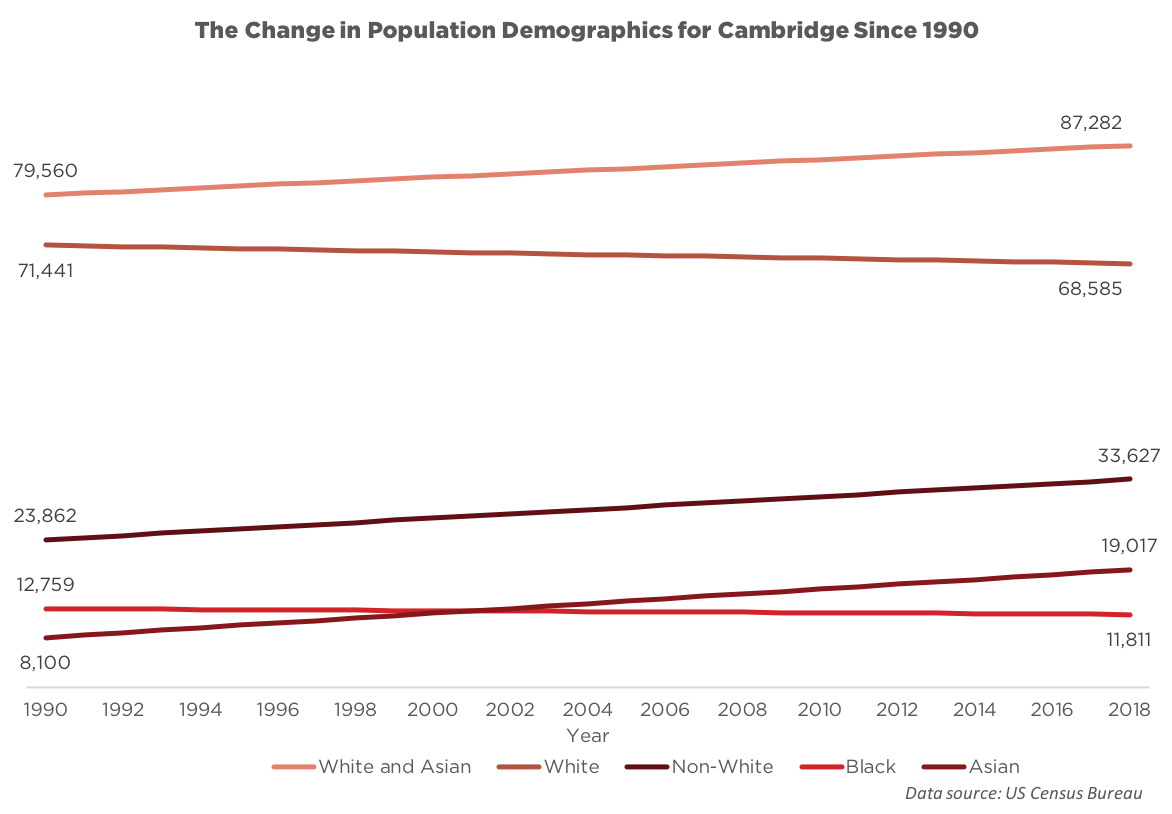
The black population of Cambridge has been steadily declining since 1990, and the Asian population of Cambridge has been steadily increasing. The two groups fall under the category “non-white” or “people of color,” and are often leveraged for data in those groups. This analysis, however, paints a more nuanced picture about changing demographics in Cambridge by disaggregating the category.
It is important to note that the white population has also been steadily declining. Again, this is not indicative of any sort of “reverse gentrification;” a deeper analysis is necessary to extract nuance. One must examine the differences in the people who are leaving and those who are arriving to understand the change in the city’s essential character. An examination of cost of living and median income show that the people coming to Cambridge are much more wealthy than those who are leaving.
Cost of living is well-proxied by housing and rent prices. NeighborhoodScout summarizes the recent changes in Cambridge’s housing market. “In the last 10 years, Cambridge has experienced some of the highest home appreciation rates of any community in the nation. Cambridge real estate appreciated 62.57% over the last ten years, which is an average annual home appreciation rate of 4.98%, putting Cambridge in the top 10% nationally for real estate appreciation.” Further analysis of census and other data available about Cambridge produces similar conclusions.

The change in the prices of these houses is approximated from 1997 to 2018 with a linear fit. Real estate prices in Cambridge are not only more expensive than those in Boston, which houses many universities and a more complex real estate climate than Cambridge, but they are also rising more quickly. There has been a similar pricing disparity in the rental market over the same period.
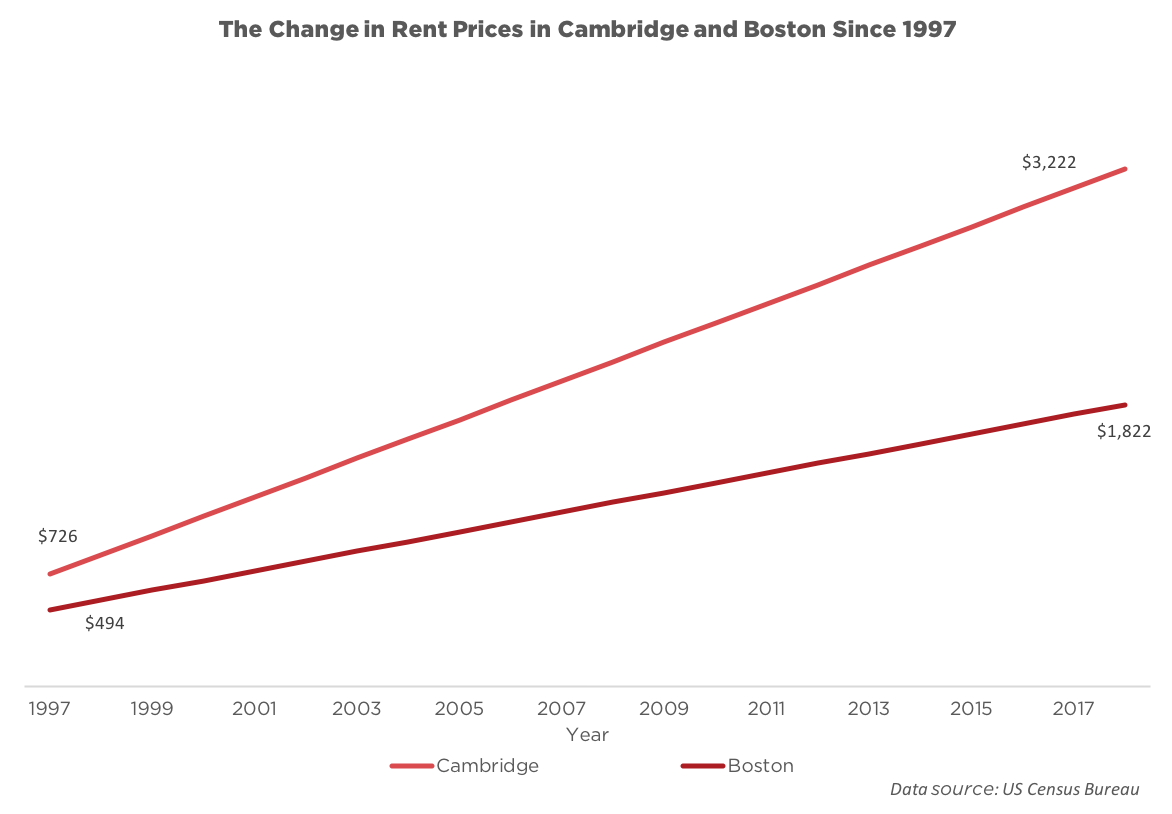
Perhaps even more worrying is that the median income of the two cities is converging; even though the costs of living in Cambridge and Boston are increasing at different rates, the income of the residents will soon be the same. For people with relatively low and stagnant incomes, this makes Cambridge a harder city to live and do business in than Boston, and incentivizes emigration. The change in rent, in particular, is important because low-income families are likely unable to buy property, and these graphs show that rent is outpacing housing prices.

As shown above, unusual appreciation of housing and rent prices matched with a relatively slow-rising median income disincentivizes living in Cambridge, and this leads to a change in the demographics of the city. Communities naturally evolve over time, so assigning negative connotations to that simple evolution is counter-productive and unrealistic. However, a key aspect of gentrification is the agent of change. Gentrification applies when the agent of change is wealthy and powerful, like Harvard University.
Property and Taxes
There are many variables that go into changes in cost of living and income, so it is difficult to assign a single agent of change. However, there are indicators of Harvard’s outsized effect on Cambridge.
The first is the fluctuation in Harvard’s property holdings in the city.

The graph shows that, since 2003, the year Summers introduced the Allston expansion, Harvard has reduced the number of its taxable properties in Cambridge. Its tax-exempt holdings rapidly increased in 2007, around the time of the financial crisis, then decreased as Harvard moved into other cities. During this same time, however, Harvard increased its payments to the government of Cambridge through the Payment in Lieu of Taxes program.
After years of negotiations, in 2011, Cambridge and Boston established a program to have non-profits with more than $15 million of tax-exempt property help offset the costs of snow removal, police and fire protection, and other services. Taxes usually offset these costs, so this payment is appropriate in the situation where tax-exempt properties are plentiful. These requested payments already take into account the positive effects the non-profits have on their cities, and are thus often quite reasonable. However, since 2012, no non-profit in this category has paid the full amount requested. In fact, in 2017, Harvard University only paid 53 percent of its PILOT.
The PILOT program was intended to alleviate bureaucratic tensions between these entities and the cities in which they reside, and offer an easier and more straightforward way for the non-profits to do business while having a minimal impact on the residents. Yet, Harvard continues to fall below the requested mark, and disparities in the balance fall on people in the community.
The Agent of Change
Harvard has a direct impact on Cambridge, as shown through analyses of its payments to the city and property expansion. The growth of Harvard, previously proxied by its endowment, is quite significant as well, and also has a direct impact. For example, the correlation between the growth of the endowment and the shrinking of the black population of Cambridge is quite clear.

A similar correlation exists between the growth of Harvard, proxied by its land purchases, and the shrinkage of the black population between 2000 and 2012.

However, this overview paints an unfair picture of causality. One could argue that both the endowment and black population of Cambridge could be controlled by some other variable, fueling this false dependency. The Python package causality and a random forest regression model were used to control for the most obvious external factors: rent and housing prices.
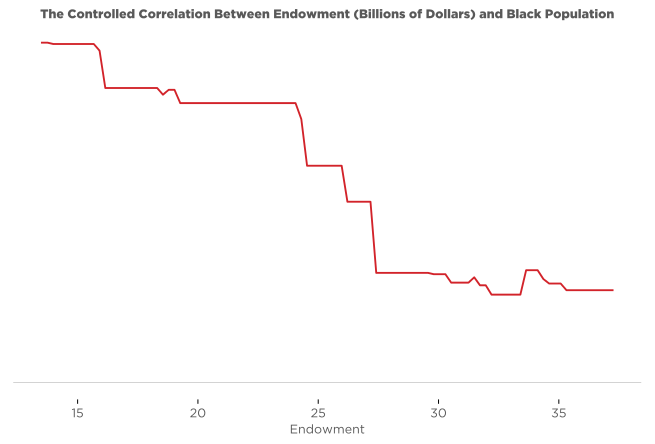
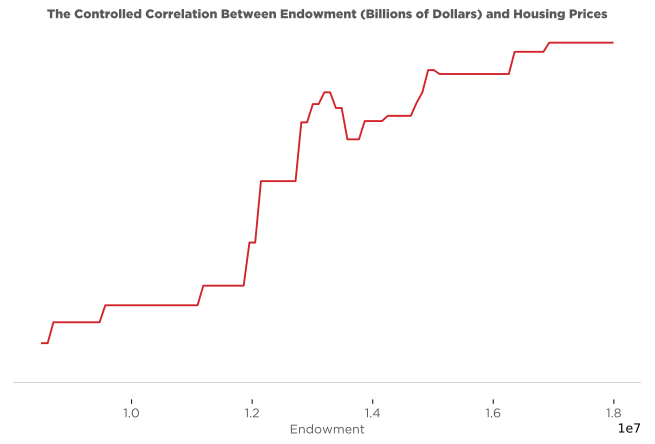
This controlled relationship, although noisy, confirms the downward trend, and thus the negative correlation between Harvard’s growth — proxied by its endowment — and the growth of the black population of Cambridge, when housing prices are controlled for. A similar relationship exists between the endowment and rent, as well as the endowment and housing, controlling for the growth of the population. Finally, for the other, more direct proxy for growth — land acquisition since 2000 — the same relationship is apparent; Harvard’s growth has brought shrinking populations of low-income people of color.
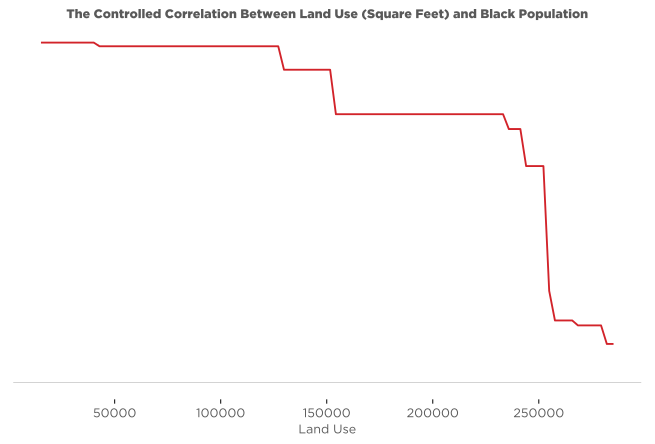
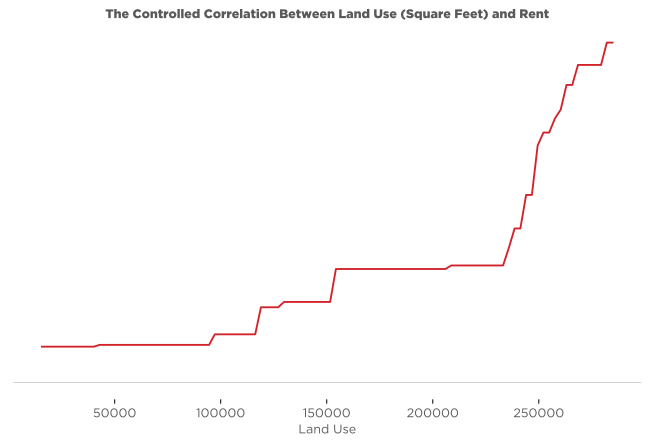
Moving Forward
As this analysis and general intuition shows, Harvard has a massive effect on the cities it resides in. The presence of the university, and its ever-growing demand for space and resources, radically changes the people, culture, and essential character of these communities. In short, the gentrification of Cambridge is an effect of Harvard’s expansion.
Harvard, MIT, and Cambridge are often thought of as one, but there are people within the city that do not have access to the resources of these universities, and they are affected negatively by their presence. Businesses and families have been priced out, paving the way for more capital-rich businesses and entities tied to the universities. When Harvard buys land, the assessed property value skyrockets, as does the cost of living in the areas where these purchases are made. The universities also refuse to pay anywhere close to the full amount of the PILOT, further offsetting the burden of operation onto the residents.
Harvard is quite aware of their impact and the possible backlash they may face from residents. Allston residents have long been uncomfortable with these expansions, forcing Harvard to make property purchases anonymously. Former head of Harvard Real Estate and former Vice President for administration, Sally Zeckhauser, said that as Harvard expanded within Cambridge, it began bumping against “mature neighborhoods with sophisticated and politically active residents often seeking to preserve things just as they were.”
This was the rationale for moving to other cities. Harvard had already displaced Cambridge residents who were not “sophisticated and politically active” — a dog-whistle for low-income people of color — so it was time to move on. Where to? Allston.
This article is the product of analysis by the Harvard Open Data Project, a student-faculty group that analyzes public Harvard data to hold Harvard institutions accountable. The raw data can be found here.
Image Credit: Wikimedia Commons/Nick Allen
